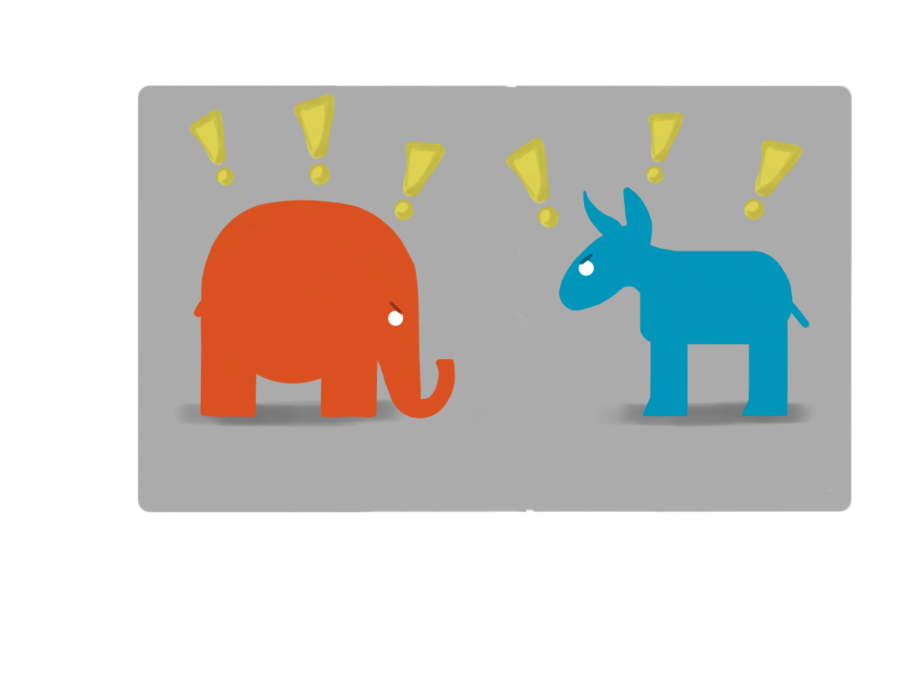The Dangers of Bifocal Politics
America’s two party-system and voting methodology actively suppress diverse political stances.
October 2, 2020
The two-party system that governs our politics is inherently undemocratic.
The two dominant political parties in America represent a limited portion of the political spectrum—liberalism and conservatism. People with political viewpoints outside the parties are forced to choose between compromising their own values or simply not participating in politics at all.
A libertarian, for instance, who believes in limited government power, may disagree with the Democrats’ social policies and the Republicans’ strict immigration platform. A social democrat who believes in strong welfare programs and a robust safety net may find the social programs proposed by both parties too weak to be effective. The two-party system’s exclusion of other ideologies from politics distributes most power to liberals and conservatives, signifying that this system is incapable of fairly representing our nation’s diversity of thought.
In fact, the presence of only two parties defeats the purpose of having parties in the first place: to represent a political ideology. Instead, the two-party system makes it only possible to group people together based on whether they are left of center or right of center, erasing the various nuances in people’s beliefs. The Democratic Party, for instance, has come to represent the democratic socialism of Alexandria Ocasio-Cortez and Bernie Sanders, along with the moderate liberalism of Joe Biden and Nancy Pelosi. The two-party system forcibly smoothes over these distinctions, uncomfortably mashing together anybody remotely left of center under the banner of “liberalism.”
The Republican Party suffers from a similar problem. While many represented by the Republican Party are libertarian social conservatives, their subtleties are glossed over, particularly between the economics-focused moderate wing and the nationalist conservative wing. Mitt Romney represents a centrist view on most social issues, while Donald Trump represents a more extreme, nationalist current in conservative politics.
To some, the solution to this problem is obvious—vote for a third party. However, the extremely slim chance of any third party actually winning an election would make voting for a third party tantamount to not voting at all, creating a vicious cycle that further solidifies the dominance of the two-party system. This arrangement we have today is not a result of media bias, or backing from billionaires, or just the way things “have to be” —it is an intrinsic, yet preventable, consequence of the way we vote.
The United States uses the first-past-the-post voting system, in which each voter can only cast one vote; whoever wins the most votes wins the election. While this method is effective if the candidates are different enough, it hurts candidates that are more similar than not. The vote for the ideology they both represent can be split between them, disadvantaging them both and possibly costing either the election, even if the ideology they represent is the most popular.
In these types of situations, voters are then forced to vote for the candidate with the greatest chance of winning to prevent vote splitting, even if they favor another candidate. Vote splitting can even be used intentionally to harm an opponent. For instance, Kanye West has received Republican funding and assistance—not because Republicans necessarily support West over primary candidate Donald Trump, but because they know that West will take votes away from Joe Biden, their biggest opponent.
Luckily, there are alternate voting systems without these issues. Instant-runoff voting, or IRV, is a form of ranked-choice voting in which voters rank the candidates in an election instead of only choosing one. After voters’ first choices are counted, if no candidate has a majority of votes, the candidate with the least amount of votes is eliminated. Their votes go to the voters’ next choice. Once a candidate has a majority of votes, they win the election. By letting voters rank candidates, they are no longer forced to choose between two candidates that they may both agree with, meaning that vote splitting is no longer possible.
Ranked-choice voting systems have already been implemented in many parts of the world, including some parts of the United States. Maine, for instance, uses ranked-choice voting for House and Senate elections, and San Francisco uses ranked-choice voting for many city elections, such as the election for mayor. Australia, India, Pakistan, and Scotland all also use ranked-choice voting. If ranked-choice voting is possible in these countries, it should be possible throughout the United States as well.
The dominance of two major political parties in American politics fails to represent the American people’s broad range of beliefs and interests fairly. Solving this issue, however, is not as simple as just voting for a third party or trying to reform the existing ones—rather, it requires fundamental changes to the way we elect representatives and officials.


